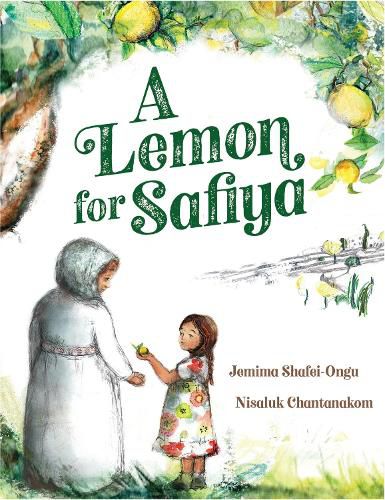A lemon for Safiya by Jemima Shafei-Ongu. Illus. by Nisaluk Chantanakom

Safiya first notices her. An older woman sitting in the gutter near their house. She notices her different clothes as she and Mum come closer to the woman, noticing the bright yellow lemon in her hand. They try to speak to her, wondering where she lives. They put her in their car and drive around the streets hoping to find her home. Safiya’s mother speaks to her in Arabic, asking where she lives. But every question Mum asks results in a response from the women’s past. She talks of playing amongst the olive trees, telling them that her father had built their house, brick by brick. When they pass a large lemon tree, she calls out that Hanna had planted that tree. In asking further questions, Mum finds that Hanna was her daughter, and the word means happiness in Arabic. But they find that the woman has lost Hanna. Safuya sits next to Maryam, telling her her name, and notices a bracelet on her wrist. They realise that is in an address. Dad turns the car around. They drive to the street that is Maryam’s street, and see a family and neighbours searching for her. A happy reunion ensues with the families sitting down together, and as Safiya offers her the lemon, Maryam gives it back to her, a gift to someone who has shown compassion from an old woman who is losing her memory.
This delightful story of loss and hope, will energise readers to think about Maryam and what has happened to her. Readers will love finding the woman’s home and communing with the family, pondering the importance of the lemon tree.
Through the story are Arabic words which can be accessed in the glossary at the end of the book. Children will be able to read the story with the Arabic words, adding some new words to their vocabulary.
The beautiful illustrations show the old woman’s lined face, each holding a story. Her clothes are delicately shown, encouraging readers to look at how people dress and what group wears this particular style. The gentle colours used when Maryam talks of her past are a wonderful contrast to the other pages, and encourage readers to think about what these illustrations show about her past life.
The gentle woman holds her child close to her, yellow the main colour in the background. Readers might like to find out where lemons are grown and where the lemon tree first came from, and think about why the lemon is important to the older woman.
I love the endpapers with the lemons, and the families sitting down together, the page of Arabic words, and the images of the old woman sitting in the gutter. Each poses questions which will form a point of discusion among the class members.
A thoughtful story to present to a class, with lots of hints about time and place, of what has happened to Maryam and what is happening at the moment. Teacher's notes are available.
Themes: Lemons, Dementia, Family, Memory, Loss.
Fran Knight